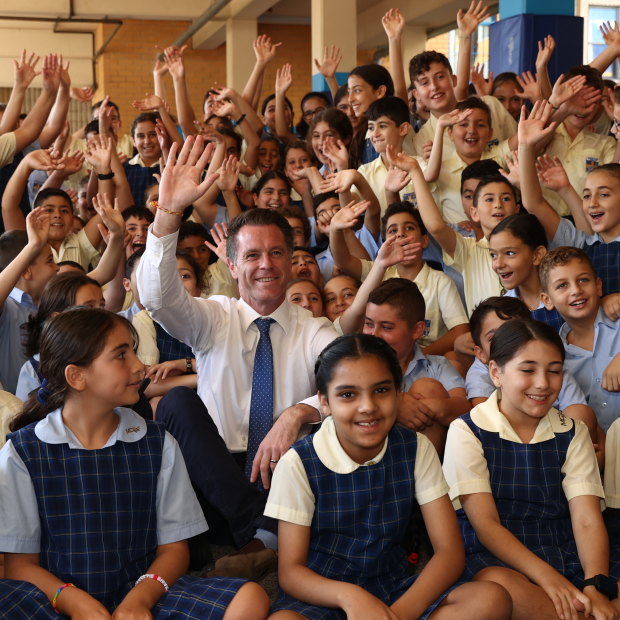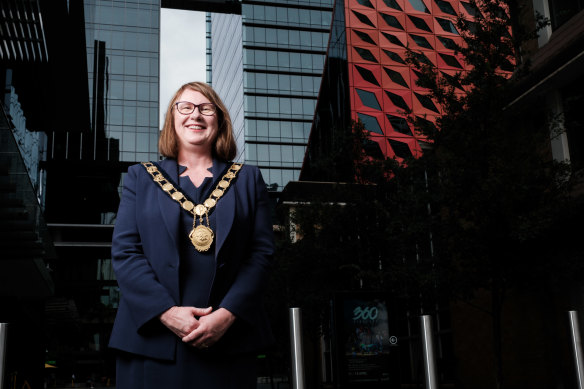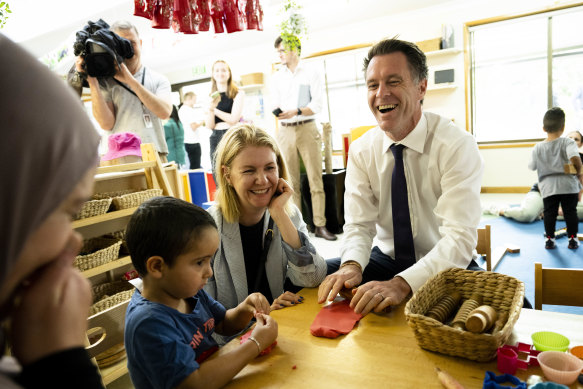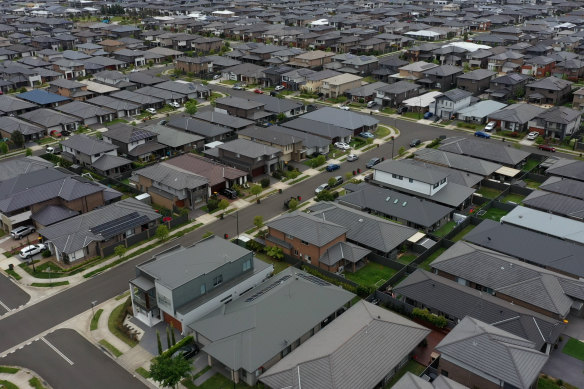This was published 1 year ago
A ‘rat-cunning piece of magic’: How Labor won Sydney’s west
By Jordan Baker and Matt Wade

NSW Labor Leader Chris Minns visits the Maronite College of the Holy Family in Harris Park in the electorate of Parramatta.Credit: Dominic Lorrimer
Liberal Geoff Lee won the seat of Parramatta off Labor in the Coalition’s landslide victory of 2011. But after 12 years in government, and with a toddler at home, he decided to hang up his boots. Lee announced his departure in August 2022, but as in so many Coalition seats, his replacement was not selected until late January, two months before the election. The delay gave Labor’s candidate, Parramatta Lord Mayor Donna Davis, a significant advantage. “It’s crazy to select people at such a late stage,” Lee says. “You set them up to fail.”
Lee’s departure was just the start of the Liberal Party’s problems in Parramatta, a city that has transformed over the past 10 years from Sydney CBD’s tired, rundown cousin to a thriving centre of education and business, where skyscrapers are rising at a rapid rate, fancy restaurants sit alongside sandstone buildings from the colonial era, and a young, creative crowd is forging its own cultural identity in its inner urban suburbs.
When the votes were counted last Saturday night, Parramatta was among the first Liberal seats to fall. The story of its rejection of the Coalition last weekend is the story of the NSW election writ large; a tale in which restlessness and financial pain, helped along by unforced errors such as tardy preselections, drove a return to Labor.

The ALP picked its candidate for Parramatta, Lord Mayor Donna Davis, well ahead of the March poll.Credit: Oscar Colman
Once fringed by homeowners on quarter-acre blocks, Parramatta is now a city of apartments. It has the highest proportion of millennial voters in the state (born between 1981 and 1996), the second-highest share of renters, and the lowest share of outright homeowners. That, too, was a challenge for Coalition candidate Katie Mullens and the Liberal Party, which, as David Cross from Liberal-aligned think tank Blueprint Institute points out, has “an image problem with young people”. Labor now holds 15 of the 20 most youthful electorates in the state.
The migration of government agencies and departments to Parramatta also worked against Mullens. Public servants lean to the left of politics anyway, and their pay became a key election issue when Labor said it would remove caps on potential wage rises, but former Premier Dominic Perrottet defended them as necessary for fiscal prudence. This was personal for the electorate’s 1348 nurses, who cluster near Westmead Hospital and felt burned out and underpaid after the pandemic.
Above all, Parramatta’s vote was driven by a worsening financial squeeze, as rents, interest rates and power bills climb. In the west, this was a cost of living election, and Labor’s key promises were proxies for financial relief. Removing the public sector wages cap equated, in voters’ minds, with higher salaries, and leader Chris Minns’ vow to protect Sydney Water from privatisation was seen as a symbolic bulwark against rising bills, despite the Coalition’s insistence that there were no plans to sell (moderate Liberal powerbroker and lobbyist Michael Photios described Labor’s strategy as a “rat-cunning piece of magic”).
The other thing about Parramatta is that it is not, historically, a blue seat. It’s held by Labor federally and was won by Lee and the Liberals at state level in Australia’s biggest electoral routing since WWII, when voters punished a tired, scandal-plagued, 16-year-old Labor government. It is a similar story in East Hills, Camden and Ryde (where Labor was slightly ahead on Friday). Every one of the five seats won by Labor in the west had been lost in the final throes of its last government. By campaigning on its traditional turf – a better deal for battling families – Labor clawed back territory that used to be considered heartland.
Liberals say they lost government due to financial pressures beyond their control, and a “time for a change” mood after 12 years. In other words, the Coalition was fighting bad odds and the election had been the opposition’s to lose. “[Labor’s campaign] worked because there was a readiness on the part of the public in difficult times to vote for change,” Photios says. Labor disagrees. “The Libs were outplayed in every facet,” the Labor strategist says. “The job of a campaign is to manage the dynamics you’ve got in your favour and use them to win.”
Rarely has a mood for change been as clear as it was in 2011, when NSW voters went to the polls with baseball bats after 16 years of Labor. Barry O’Farrell’s government ended up with 69 lower house seats, picking up 12 in the west. The people of NSW chose a new government last weekend, but the decision was less emphatic. As counting continued late on Friday, Labor was ahead in 46 of the 93 seats in state parliament, one short of majority government. The Coalition was on track to hold 35 seats, 12 fewer than before the election. There will be 12 crossbenchers, three Greens and nine independents, which is equivalent to an eighth of the seats in parliament.
As well as the losses to Labor, the Liberal Party relinquished the outer southwestern Sydney seat of Wollondilly to the independent Judy Hannan and went backwards in many of its traditional strongholds in Sydney’s north. There were double-digit swings against the Liberals in the still-blue seats of Castle Hill (-13 per cent), Hornsby (-12 per cent), Kellyville (-11 per cent) and Davidson (-10 per cent). The swings mean the Liberals must defend a raft of newly marginal seats at the next election, including Miranda, Oatley and Winston Hills. Nevertheless, they begin opposition in a better position than Labor did.

NSW Labor Leader Chris Minns and his wife, Anna, visit an early learning centre in Condell Park on the campaign trail.Credit: Janie Barrett
Back in 2011, O’Farrell used his mandate to make major changes to industrial relations in NSW and cap public sector wage rises at 2.5 per cent. When inflation was low, it wasn’t an issue. But as the cost of living climbed, the pandemic tested frontline workers, and hospitals and schools began facing serious staff shortages. Resentment grew.
Minns said he would scrap the cap. Perrottet stuck to the O’Farrell line, arguing that the state could only afford infrastructure if it kept a check on its wages bill. Polling showed Perrottet’s position was unpopular. By the final two debates, he’d stopped using the phrase “wage cap” altogether. “There’s half a million public servants in NSW,” says one senior Liberal, on the condition of anonymity. “If you add partners, families, that’s almost a million. One guy is saying he’ll lift the cap, the other is being Uncle Scrooge. That broke through as a retail issue in the end.”
An analysis of the electorates in which teachers and nurses live shows high numbers in seats that either fell to or swung significantly towards Labor, such as Camden, Parramatta, Heathcote, Riverstone, Miranda and Terrigal. Teachers and nurses were out in force in many of those electorates on polling day, lobbying not for a political party but for their profession. “It was incredibly powerful to be standing next to nurses and teachers [who were] asking you not to vote for the Liberal Party this time,” says the Labor candidate for Ryde, Lyndal Howison.
Electoral analyst and editor of the Poll Bludger website William Bowe says Chris Minns’ commitment to dump the public sector wages cap helped Labor perform strongly with voters in what he calls the “new working class”, which includes teachers, nurses and other public sector workers. “Labor normally does well with that group, but they have done particularly well this time,” he says. “In electorates where public sector workers are concentrated, the ALP has batted well above average.”
Labor’s campaign on Sydney Water also cut through. Privatisation has long been electoral poison; it was one of the reasons for the demise of former Labor premier Morris Iemma. Still, the Coalition’s Mike Baird took the sale of the state’s poles and wires (the electricity distribution system) to the 2015 election and won. But electricity prices are soaring now, and Labor’s anti-privatisation strategy worked. “I think Riverstone, the outer west, Leppington, Camden and Penrith were [won] primarily on the back of water privatisation,” the Labor strategist says. “It’s water. People don’t want to be tapping the credit card for something so fundamental.”
As always, in any election, local issues also drove votes. Outer western Sydney seats that opted for change, such as Camden, Leppington and Riverstone, share a frustration over rapid development and a failure of schools, healthcare and transport services to keep up. For some, the ghost of the unpopular Morrison federal government may have lingered. “I think there’s still residual problems in the Chinese community from [former prime minister Scott] Morrison and [federal Opposition Leader Peter] Dutton’s attack,” the Labor strategist says.
Demographic changes also played a part. Resolve Political Monitor surveys conducted for the Herald before the election showed that generational trends helped Labor.

Residents of Marsden Park, in the electorate of Riverstone, live in an area that is big on development but short on services.Credit: Rhett Wyman
“Urban areas are getting younger relative to other regions, and the younger you are, the less likely you are to vote for the Coalition and the more likely you are to lean to progressive politics,” says Resolve director Jim Reed, who conducts the survey. He believes the centre ground of politics, where elections are won and lost, has shifted “a little” to the left. “People have more expectations of governments now, particularly post-COVID, and see a role for them in social issues,” he says.
The “it’s time” factor doesn’t always translate to a win. Voters were weary of the federal Coalition in 2019 but scared off by Bill Shorten’s ambitious policy platform. In an election such as this, however, “it’s very rare that [the soft vote] will swing in favour for the swinging government,” Photios says. “In the last week, the apparent victory of Chris Minns [in the Sky News debate] was a significant last-minute influence. Not because anyone watched the debate. But because the media the next day was wall-to-wall about the victory of Minns ... if you’re an undecided voter ... the pyschological inputs will lead you to vote against the government of the day.”
Reed described the election result as a “shoulder shrug” change in government, rather than the angry “fist shake” by voters. “Many people seemed to say: ‘I don’t think there’s much risk to change, let’s try something new’. The alternative to the Perrottet government appeared acceptable and fairly safe.”
The post-mortem is under way at Liberal HQ, where the shock of last Saturday night has turned into grim optimism as this week’s count of postal votes and preferences shows the party’s loss was not as catastrophic as first feared. The Coalition held off a challenge from so-called teal independents on the left and One Nation on the right, and kept many of its seats, if only by a slight margin. Many hope that Minns could lead a one-term government, like Steven Marshall’s in South Australia.
“There’s a huge turnover now in governments, and we’re well placed,” Photios says. “The good news for the Liberal Party is that if our problems are structural, like preselection – and they are – they can be fixed. We can’t afford that structural mistake again.”
Others, however, worry that the problems run deeper, and a landslide would at least have forced the party to take a long hard look at itself – particularly at its preselection pathway, which rewards people who have time to devote to winning over mostly older, mostly male branch members. “There’s so many disgruntled people who feel like they are banging their heads against a brick wall,” one high-profile Liberal says. Another says: “As a point of honour, nobody in the state secretariat should turn up for work next week. We’ve known this was coming for four years. They were still doing things at five to midnight.”
Meanwhile, Minns and his leadership team face the daunting task of delivering on their promises. While it begins the complicated work of establishing a government – hiring staff, appointing new departmental secretaries, getting across issues – it must also move swiftly to manage the expectations of those nurses and teachers, who will anticipate reward for their vote with a noticeable change for the better at work.
But for a moment, Labor will savour victory. “There was a scenario in which we could have lost this election,” the strategist says. “We saw our track tightening in the early parts of the campaign. If we hadn’t driven the discipline of campaigning on privatisation and wages cap, then I think Perrottet could have emerged as a popular incumbent that deserved another go.”
The Morning Edition newsletter is our guide to the day’s most important and interesting stories, analysis and insights. Sign up here.